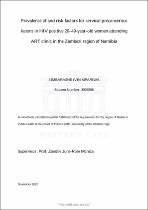| dc.contributor.advisor | Mchiza, Zandile June-Rose | |
| dc.date.accessioned | 2023-05-11T08:56:01Z | |
| dc.date.available | 2023-05-11T08:56:01Z | |
| dc.date.issued | 2022 | |
| dc.identifier.uri | http://hdl.handle.net/11394/9921 | |
| dc.description | Masters of Public Health - see Magister Public Health | en_US |
| dc.description.abstract | Background: By 2020 cervical cancer was the fourth most prevalent cancer in women worldwide. In Africa, cervical cancer is the second most prevalent malignancy with the highest incidence in Sub Saharan Africa (SSA). Cervical cancer was reported to be the second most prevalent cancer in Namibia from 2010 to 2014. On the other hand, SSA has the highest global burden of human immune deficiency virus (HIV) which predisposes individuals to persistent human papilloma virus (HPV) infections. Human papilloma virus infections promote the development of precancerous lesions that may later lead to cervical cancer. Aim: The aim of the proposed study therefore was to determine the prevalence and risk factors for the development of cervical precancerous lesions in women living with HIV (WLHIV) who accessed health services at Katima Mulilo Hospital antiretroviral therapy (ART) clinic in the Zambezi region of Namibia. The precancerous lesions were diagnosed through visualization of the cervix under acetic acid (VIA) | en_US |
| dc.language.iso | en | en_US |
| dc.subject | Cervical cancer | en_US |
| dc.subject | Precancerous lesions | en_US |
| dc.subject | Visualisation of the cervix through acetic acid (VIA) | en_US |
| dc.subject | Women living with HIV (WLHIV) | en_US |
| dc.subject | Screening | en_US |
| dc.title | Prevalence of and risk factors for cervical precancerous lesions in HIV positive 20–49-year-old women attending ART clinic in the Zambezi region of Namibia | en_US |
| dc.type | Thesis | en_US |

